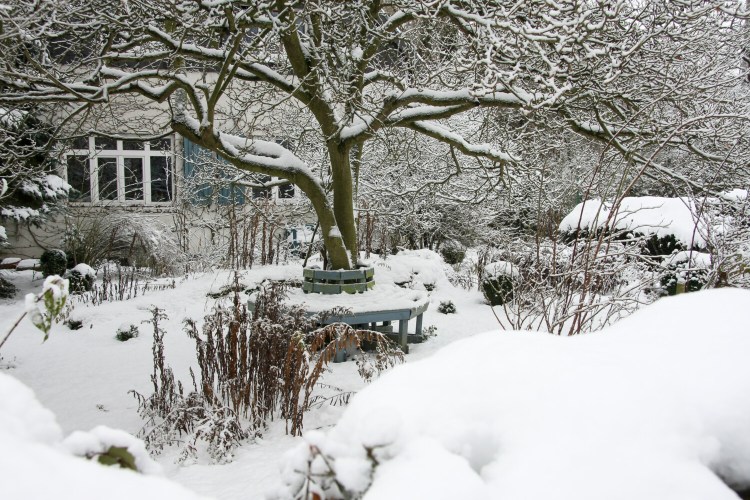What’s the most important thing to take into account when working out landscaping for this time of year: How do things look from inside the house?
In our case, yes, we are Mainers and we are tough. We ski (both downhill and cross-country), skate when the ice is right, snowshoe, go sledding when the grandchildren are visiting, snowmobile and sometimes take a simple walk. But unless you own an acre or more of land, all those activities require leaving your own personal landscape. When you are enjoying your own property at this time of year, you are usually looking out a window.
From that viewpoint, the part of the landscape that new homeowners think about first – foundation plants – is useless. If you can see them easily from inside, they are blocking your view of the rest of the garden, not to mention blocking much desired sunlight, too. If they are below the bottom edge of the window, you have to look down to even see them from inside.
People plant foundation evergreens because they think they want some color in front of their house in the winter. Maybe that works, but the short evergreens are under snow most of the winter and the tall ones block your windows. In fact, the most important parts of the yard come winter are those at least 10 feet away from the house. Some stretch to the horizon.
The view my wife, Nancy, and I talk about most is toward the west, where we enjoy sunsets while having a glass of wine before dinner – at least at this time of year when the sun sets early.
Our vegetable garden is located toward the west, but several features make the view more interesting than the level earth where peas, tomatoes, potatoes and a lot of volunteer flowers grow in the warmer months. A see-through fence – handmade of evenly spaced 3-inch slats – separates the house from the vegetable garden. In the middle of the fence is an arch where wisteria climbs. We grow perennials on both sides of the fence, and at this time of year many of the perennials – Autumn Joy sedum seems to dominate – poke above the snow. And, yes, our vegetable garden is in front of our house. This is Maine, and there is a giant streak of ledge in our backyard.
At the far end of the vegetable garden is a disorganized hedge, made of three balsam firs that we planted when we were using living Christmas trees and two Hicks yews that we rescued when a friend was getting rid of them. They make an attractive border of our property at any time but look best when covered by a fresh snow. The “hedge” also includes a number of deciduous shrubs that don’t really show up at a distance without their foliage.
The evergreens are 10 to 20 feet tall now, and getting wider every year. I am tempted to cut them down – we removed one fir several years ago – because they are eating into the space for our vegetables. But I would miss them, and we already grow more vegetables in our garden than we can eat.
We don’t own the property that makes up the view beyond those evergreens – but we own the view. Oaks and maples penetrate the sky all the way to the horizon, and the setting sun filters through the naked branches of those trees.
We didn’t carefully plan this western view that I like so much. We killed at least two balsam living Christmas trees in the woods to the north of the house, where they died from lack of sunlight. We chose the site for the current balsams because we thought they would live there, and it worked.
The eastern backyard garden is the one I look out at most often. My office window faces this garden from the second floor, and it’s where we look when when working at the kitchen sink.
This garden is more carefully planned. It has a fence similar to the one by the vegetable garden, although taller. We went two years without a fence after wind and rot did in the previous one, thinking it unnecessary as we get along just fine with our neighbor. But a fence, we discovered, sets the plants off better.
This garden has plenty of azaleas and rhododendrons for spring bloom, and the evergreen species look good at this time of year. Other plants include a native witch hazel, which has understated catkins in late fall and good structure; a compact weeping hemlock that I love dearly; and three species of dwarf chamaecyparis. These “dwarfs” are six to 12 feet tall, compact only by comparison; the full-sized ones reach 40 to 60 feet.
What about the other two sides of the house? Well, the garage is on the south, built as close to the lot line as allowed, so we can’t see anything in that direction. The north is a natural woods, which we have pretty much left alone except for adding some native understory plants over the past few years.
It looks good, but the only credit we can take is for mostly ignoring it. Early in our residence, we cut down oak saplings in that area while also removing alders, multiflora roses and bittersweet.
Sometimes it’s not what you plant, it’s what you remove.
Tom Atwell is a freelance writer gardening in Cape Elizabeth. He can be contacted at: tomatwell@me.com.
Send questions/comments to the editors.


